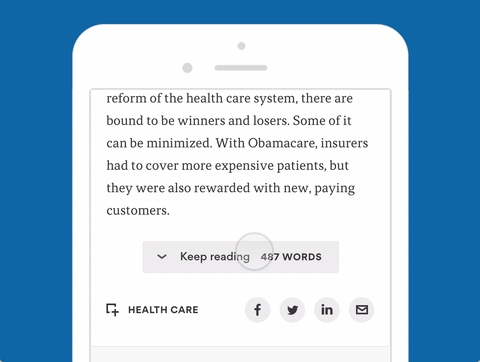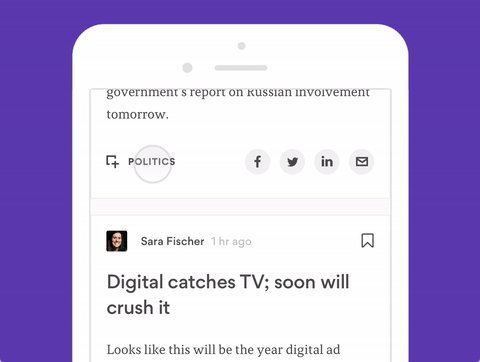Chances are, you’re not going to finish this article.
The rise of social media has turned us into a legion of swipers and scrollers who rarely reach the end of a story.
The team behind Axios, a new startup from the founders of Politico, knows this. That’s why they’ve built a product designed to resemble a cross between Twitter and The Economist.
“It really seemed like the stream — the same thing Facebook and Twitter do — was a good way to consume a lot of information very quickly,” said Roy Schwartz, co-founder and president of Axios.
On Wednesday, visitors to Axios.com will be greeted by a vertical stream of news that resembles the Facebook timeline, or Twitter’s feed. But instead of posts from friends or celebrities, Axios’ feed will consist of short, newsy bulletins created by the company’s team of writers and curators.

The Axios feed. (Image courtesy Axios)
The stream was conceived as a concise digest that puts the reader in control, Schwartz said. Most items in the feed are very short (less than 800 words), and readers are presented with a brief excerpt of each item accompanied by bullet points and pull quotes.
If they’re intrigued, readers can tap a “keep reading” button that surfaces the rest of the article without taking users out of the original story stream.

The “keep reading” option within the Axios stream.
A third feature of the Axios stream is “read another,” a button at the bottom of each Axios item that surfaces another story on the same topic. This is designed to help readers discover new articles relevant to their interests while keeping them in the news feed.

The “read another” option within the Axios feed.
The overall feeling these features create is that of a nesting doll, with individual articles nestled within excerpted summaries within a larger news stream. This idea runs counter to the principles of news design on many major websites, which put greater emphasis on article pages. But because every excerpt can be shared on social media, readers are left with a single page that’s composed of dozens of mini-articles.
The design was based on a listening tour undertaken by Axios’ co-founders, who wanted to better understand how people were consuming the news, Schwartz said. The prevailing response: People felt inundated with news and information and spent too much time deciphering what was worth reading and what wasn’t.
Thus the feed, Schwartz said. By shortening the information and selecting only news from people “authentically wired” into their beats, Axios is aiming to deliver the most value with the fewest characters.
“We’re very much reader-centric,” Schwartz said. “The reader decides how much they want to do and how deep they want to go.”
Axios isn’t betting that all of their readers will flock to the website, though. Instead, the company has adopted a distributed strategy for their journalism — they will create journalism designed for platforms such as Facebook and Snapchat in addition to publishing articles on the Axios website.
On Facebook, VandeHei and company are putting a twist on the Instant Articles feature to create a modified product they call “Instant Axios.” It most resembles Vox.com’s card stacks, a series of concise briefings that each describe a larger story.
The company’s presence on Snapchat, meanwhile, will be a tweaked version of “We The People,” the Snapchat Discover channel that VandeHei created to chronicle the runup to Election Day. Stories will be changed to fit the platform they fit on, whether it’s Snapchat, Facebook or Axios.com.
“We believe the future of news on social platforms is a publisher within a platform,” Schwartz said. “…If you don’t want to leave Facebook to consume the information, we’re OK with it, as long as you learn about our brand and trust our brand.”
And, presumably, as long as readers consume ads within those platforms. Axios has designed advertising cards to fit each of their products. These ads take up an entire screen rather than interrupting an article, which puts promotions front-and-center without distracting from the text.
In addition to advertising, Axios is planning to pull in money from a subscription business that’s slated to cost around $10,000 per user. But the basic design of the news stream won’t change for subscribers, Schwartz said. They’ll be served information in the same nested feed the general audience uses to find news.
“We’re still in the early stages of what the subscription model will become,” Schwartz said. “I think in the next few months, we’ll solidify that model.”






